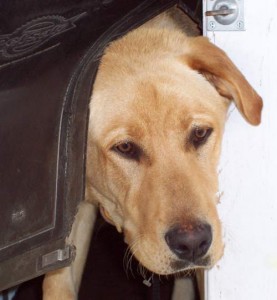Does your dog fly out the door when it is opened? Run into the street from the front lawn? Leave the room you are in to maraud around the house on his own? Your dog could use some safe and practical boundary training!
Teaching dog boundaries requires just three things:
- a dog
- a long line
- a regular or training collar
With a long line attached to your dog via his collar, you can teach your dog to respect virtually any boundary – whether it is the edge of the lawn, the threshold of your front door, or the doorway of the room that you are in. Here’s how:
- Choose the boundary you want to teach.
- Put a collar on your dog (either a flat collar, or a training collar like a slip chain, a martingale or pokey style).
- Attach a long line of 15-30 feet to the collar and hold the other end.
- When you dog reaches the boundary you want to teach, POP the long line to give a quick, sharp “that’s far enough” message through the collar. If your dog tries again to cross the boundary, POP the line again. The long line and collar are, in essence, acting like an invisible fence, which the dog encounters each time he tries to cross the boundary.
Repeat this several times. Enlist the help of a friend or family member as an assistant, and have them cross the boundary, as you reinforce the do-not-pass rule for your dog. Very soon, you will have a dog that will NOT bolt through the door, run across the street or leave the room that you are in, because he will believe and respect the boundaries that you have defined for him.
Try it! This is especially effective for young puppies, but can work with any age dog. Here’s to a safer life ahead through better boundaries for our dogs!
-Diva











4 Responses
Thanks for your tips diva. I have a problem with my 12mo. Bullmastiff with this technique as he will just get frustrated and chew on leash or cable etc…when you give him a correction
Hi, Stacey:
Your puppy’s behavior tells me he is not convinced that submitting to your boundaries is going to be more fun than doing things his way. (Hey, he’s got a streak of Bullmastiff-stubborn, right??) I would try the following technique to change his mind:
Continue to “pop” his long line when he tries to cross a forbidden boundary. THEN offer him a small reward, like a tiny treat or petting. Make doing things your way more pleasant for your dog and he will become much more cooperative, I assure you. Right now, he may feel submitting to your boundaries gets him the proverbial “short straw”. Make him WANT to obey by acknowledging his efforts and making the results of his obedience more fun and worthwhile!
I have other ideas if this doesn’t work, so keep in touch!
-Diva
We went to your class many years ago and loved it, but this Westie of ours just likes bolting out the door still….Of course, I just tried the line on her just a couple of times years ago, but after reading your method, again, I shall try again even though she is 12 years old and does what she wants to do….I think we are the ones that should be trained. ha ha
Thanks again for your good ideas and again, we so enjoyed your class when we took it…
Betty Clyde
Informative article, exactly what I waas looking for.